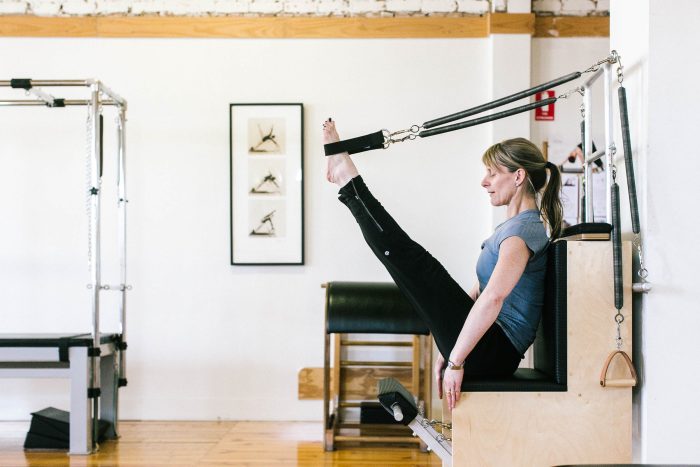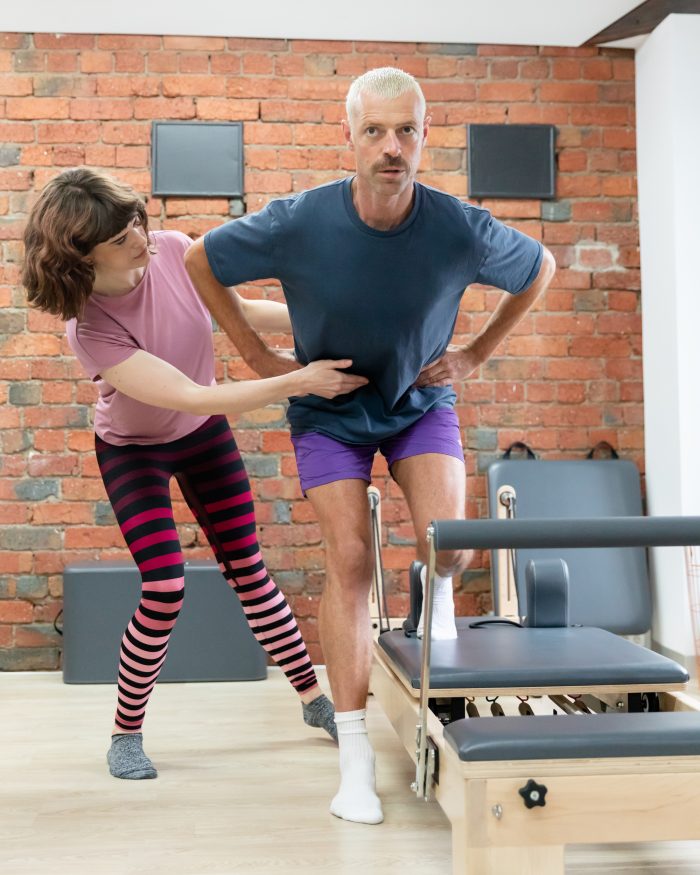
Pilates is movement. Pilates is Exercise. But what is our point of difference?
Joseph Pilates created Contrology as a corrective system of exercise to provide complete coordination of the mind, body, and spirit, supporting a holistic approach to health, fitness, and happiness. We are now amid a Pilates evolution, making this an opportune time to reflect on what sets us apart from other exercise modalities.
In addition to our unique apparatus and specific Pilates repertoire, our main point of difference are our guiding principles. Centring, Breath, Control, Concentration, Flow and Precision.
When integrated with the concepts of movement and the tools of progression and regression, we have the ability to manipulate repertoire and our environment to create optimal and positive movement experiences for all clients.
We achieve our ultimate goal when clients leave the Pilates studio feeling invigorated both physically and mentally, lifting their spirit.
When considering all concepts, principles and movement variables and the fact they slide up and down a continuum, we have endless movement opportunities available to us. This provides the ability to create exercises and programs for clients that are not too easy, not too hard, but ‘just right’. Strategic application allows movement to be broken down into its most simple form to unload, enhance alignment and motor control, then progressively build back to functional movement with renewed control and efficiency – often all in the one session.
This sounds simple in theory, but in practise is very challenging.
We need knowledge of all the variables, understanding of how they affect movement and be able to integrate this into teaching clients effectively.
Our own self-mastery is key to developing this skill set. Once mastered, movement is guided by knowledge and purpose, rather than by a strict set of rules. We must also be keen observers, identifying when clients are under or over working, and differentiate between negative compensatory movement patterns and positive adaptations.
The challenge is also what makes the Pilates method so interesting and rewarding for all involved.
It’s a never-ending journey of movement exploration, continuously layering our knowledge, skills and understanding.
With a focus on centring, we can explore how the integration of all Pilates principles supports the creation of positive movement experiences for all clients.
In terms of a definition, being ‘centred’ means being in a state of balance and equilibrium. It’s not a static state, but a place to continually return to. Centring relates to the way we control movement in relation to our centre of gravity, the centre of our joints, as well as our state of mind.
The ability to control movement from and around our centre of gravity allows us to move efficiently and safely.
This is directly related to pelvic and torso control, creating an equilibrium between associated muscles, that work in unison when moving and/or reacting to external forces. Our centre of gravity is constantly shifting with breath and movement. By keeping it within a ‘neutral zone’ we protect our body as a whole and conserve energy.
This is vital for all clients whether they have musculoskeletal conditions requiring specific movement control or whether they push their bodies to the limit through sport and performance. Maintaining our centre of gravity within our base of support is what keeps us balanced, so we don’t fall over. This is essential for sports requiring fast efficient changes of direction, but also for life in general so we can move with ease and be able to react to any mishaps.
Creating proprioception and awareness is essential for all clients. This starts with breathing and providing an opportunity for them to assess their position of body in space when still and when moving.
Once aware, clients can analyse movement patterns and play a more pivotal role in increasing their own motor control.
As precision and self-mastery increase, continuous manipulation of the appropriate variables provides progressive challenge, based on individual needs and goals. For clients with lower back pain or diastasis recti we need to ensure we don’t exacerbate pain or overload already stretched tissue, but still build capacity to support regaining optimal function. For more athletic clients we need to ensure we provide sufficient load and dynamic movement specific to their environment, while still reinforcing an equilibrium between muscles and joints.
Being centred within our joints is closely related to our centre of gravity. When we are centred within our joints (including our pelvic and spinal joints) we create optimal skeletal alignment to support safe, efficient, flowing movement.
Again, our muscles work in unison and are reactive to external forces applied to the body.

This is influenced by the type and direction of movement, as well as the magnitude and direction of the forces acting on the joint.
Staying centred within our joint’s supports joint stability. This is defined as the joints ability to withstand forces and avoid becoming, displaced, dislocated and/or injured. This relies on the optimal and constantly changing relationship between alignment, strength, stiffness, mobility, and flexibility of all structures and tissue, required of the activity. Once again being centred is not a static state and relies on the joint having a buffer/neutral zone and an ability to act like a shock absorber. This is achieved through the maintenance of equal and opposite forces within the joints.
Consolidating an understanding of neutral pelvis, neutral spine and neutral joint alignment assists proprioception and the development of more efficient movement patterns.
Like centring, neutral joint alignment is not generally a static state, but rather a starting or reference point where all directions of movement are available to the joint.
It’s a place to move from and return to and/or a zone to work within, due to it being a place of balance and equilibrium.
Providing clients with the opportunity to concentrate on movement, creates a mind-body connection and allows clients to become centred in their mind. Being centre of mind provides an inner calm, drawing attention away from the peripheral world and into themself. Pilates becomes a form of meditation and stress relief when used to switch off from work, chores, and the constant information overload of life. This is most effective when we allow clients to zone in on their own body and focus on the execution of repertoire, rather than listening to constant instruction. This requires us to be efficient teachers through succinct cueing.
Pilates is the perfect environment to integrate constraint-based learning.
This is achieved through understanding your client, your environment, and the repertoire to again provide ‘just right’ exercises. This allows clients to self-manage and enhance their own movement quality, without relying on ongoing instruction. This coupled with strategic programming and incremental progressions, leads our clients to successful execution of repertoire.
If you understand your client’s movement capabilities, can manipulate the environment appropriately (exercise choice, equipment, load, range of movement etc) and the client understands the task and goal, verbal cues can be minimised. Clients can then focus on their own execution of repertoire, providing an opportunity to self-analyse and elicit positive adaptation.
With practise and repetition, movement competency is demonstrated through precision and flow with enhanced alignment and motor control stored in client’s neuromuscular memory.
This leads to clients executing repertoire with decreased conscious control, indicating they are ready for the next layer of focus and/or challenge. Transferring movement into our unconscious neuromuscular memory is a vital step in making what we do in the Pilates studio relevant to everyday activity.
We no longer think about the way we move; we just move better for our life.
An Article by Kath Banks
Faculty Educator – National Pilates Training
